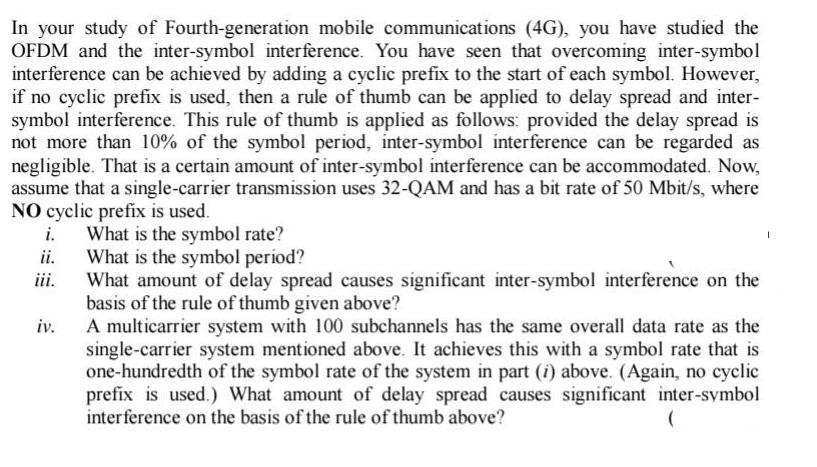Answered step by step
Verified Expert Solution
Question
1 Approved Answer
In your study of Fourth-generation mobile communications (4G), you have studied the OFDM and the inter-symbol interference. You have seen that overcoming inter-symbol interference

In your study of Fourth-generation mobile communications (4G), you have studied the OFDM and the inter-symbol interference. You have seen that overcoming inter-symbol interference can be achieved by adding a cyclic prefix to the start of each symbol. However, if no cyclic prefix is used, then a rule of thumb can be applied to delay spread and inter- symbol interference. This rule of thumb is applied as follows: provided the delay spread is not more than 10% of the symbol period, inter-symbol interference can be regarded as negligible. That is a certain amount of inter-symbol interference can be accommodated. Now, assume that a single-carrier transmission uses 32-QAM and has a bit rate of 50 Mbit/s, where NO cyclic prefix is used. i. What is the symbol rate? What is the symbol period? iii. ii. What amount of delay spread causes significant inter-symbol interference on the basis of the rule of thumb given above? A multicarrier system with 100 subchannels has the same overall data rate as the single-carrier system mentioned above. It achieves this with a symbol rate that is one-hundredth of the symbol rate of the system in part (i) above. (Again, no cyclic prefix is used.) What amount of delay spread causes significant inter-symbol interference on the basis of the rule of thumb above? iv.
Step by Step Solution
★★★★★
3.42 Rating (158 Votes )
There are 3 Steps involved in it
Step: 1
ANSWER EXPLANATION a In simple words 4Gfourth generation is nothing but it is the s...
Get Instant Access to Expert-Tailored Solutions
See step-by-step solutions with expert insights and AI powered tools for academic success
Step: 2

Step: 3

Ace Your Homework with AI
Get the answers you need in no time with our AI-driven, step-by-step assistance
Get Started


